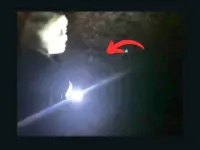Listed below are ten of the most bizarre ghosts and demons from Japanese folklore.
Japanese folklore is filled with stories of yurei (ghosts) and oni (demons) that have been a rich part of Japanese culture for thousands of years. While some of the stories about yurei and oni have been told and retold as a way to relate moral lessons and advice to younger generations, others are so frightening that it’s hard not to believe that they have some foundation in real events.
10. Yama-uba
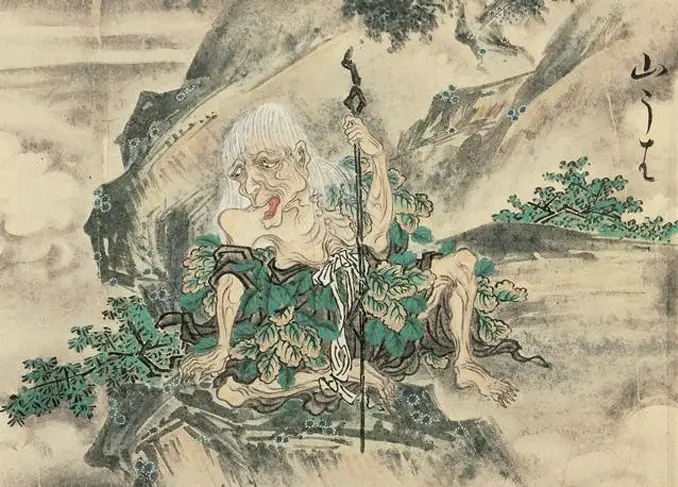
Yama-uba (mountain hag)are old hags that reside in the mountains and forests of Japan. According to Japanese culture, there are a couple of ways that Yama-uba are created. In some cases, young women who have been accused of a crime or who have dishonored themselves or their family will hide in the woods or up in the mountains where they gradually transform into the Yama-uba as they live their lives in exile. In other cases, elderly women were often removed from the home during times of famine or hardship. This was done in order to give the rest of the family a better chance of survival with one less mouth to feed. Many of these old women found themselves abandoned in the forest, where they transformed into Yamauba due to the unjust pain and suffering brought on them by their families abandoning them.
Yama-uba live in lonely places, usually in huts or hovels by a road or path. If approached by a traveler they will initially appear as a kindly old woman, offering shelter and food for the night. Once their guest has fallen asleep, Yama-uba will transform into a demonic, witchlike hag and attempt to eat their guest. They are powerful magicians and use their magic to help subdue their unwary victims so that they can eat them at their leisure.
9. Mikoshi-Nyudo
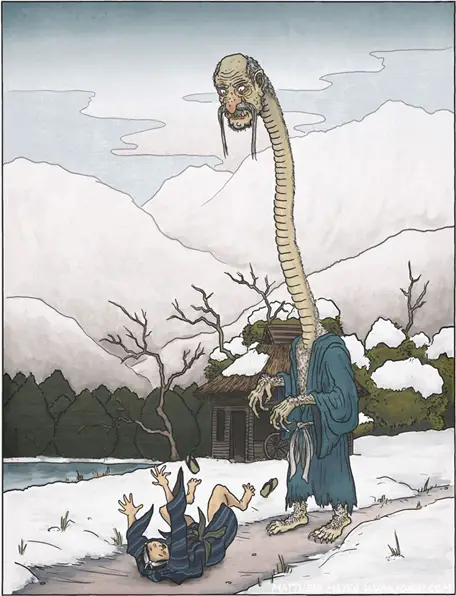
Mikoshi – Nyudo (anticipating priest ) doesn’t initially appear in a frightening form. He appears to the unwary as a wandering priest or monk, usually at intersections, bridges or lonely roads late at night when there aren’t many travelers to bear witness or interfere with his devious plans. Once encountered, Mikoshi – Nyudo grows incredibly tall with an extremely long neck. He also grows shaggy wild hair and sharp claws.
Individuals who encounter Mikoshi – Nyudo normally don’t survive the encounter. Often, if the traveler ignores this creature or attempts to walk around him, he will attack with bamboo branches and spears, killing his victim in order to devour him. Those who try to turn and run suffer the same fate. Individuals who decide to try and stare down Mikoshi – Nyudo will drop dead from fright.
There is only one way to escape from Mikoshi – Nyudo. When a person raises their eyes to look at Mikoshi – Nyudo, he immediately begins to grow, causing his intended victim to raise their eyes. Because the growth of Mikoshi – Nyudo is so rapid, his victim looks up so fast that they often fall backwards. Mikoshi – Nyudo then attacks his victim, ripping at their throat with his teeth. If the traveler looks down at the creature’s feet instead, his power will be drained, preventing him from attacking. Because the traveler has anticipated his trick, Mikoshi – Nyudo will disappear in a rage, allowing the traveler to escape.
8. Shinigami
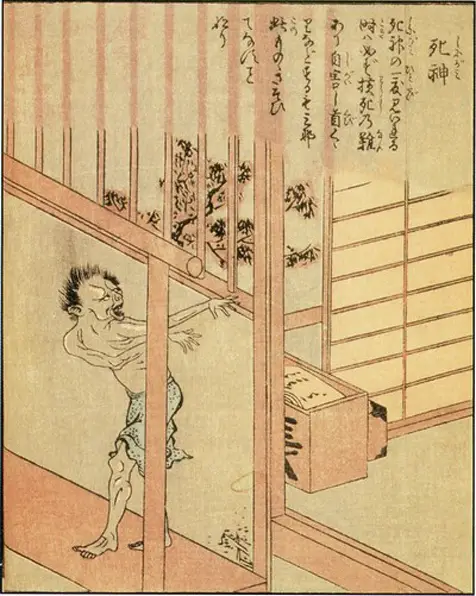
In Japanese folklore the Shinigami (god of death or death spirits) are the equivalent to the Grim Reaper. They call human beings to their death, and it’s thought that they actually possess some individuals and encourage them to commit suicide.
While the Shinigami are similar in nature to the Grim Reaper, there are some attributes that are decidedly different. In Western belief systems, the Grim Reaper is often viewed as something to be feared, with the stigma of death seen as an end of an existence and something unnatural. In Japanese culture, death is seen as a natural part of the life cycle. The Shinigami are seen as facilitators who make sure that events flow in a balanced cycle. Unlike the Grim Reaper, who is depicted as a single entity, the Shinigami typically work in pairs.
While on the surface the Shinigami are considered to be beneficial, the Japanese still believe in taking precautions to avoid accidents and untimely deaths. Even today they perform rites to appease the Shinigami in order to avoid attracting negative attention from them.
7. Gaki
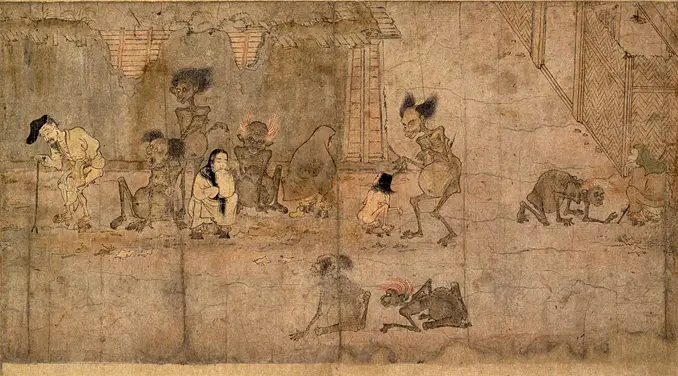
Gaki, (hungry ghosts) are typically individuals who have committed some sin or other transgression in life. As a result of this transgression, they’re reborn in the form of a hungry spirit as karmic retribution. They’re cursed with an intense craving from which they cannot escape. Often these cravings involve something unpleasant such as feces, urine or corpses, but sometimes their cravings include regular food and drink. Regardless of what it is that they crave, Gaki never find nourishment from the items that they seek. Often when they attempt to eat, their chosen food will disappear or burst into flames, or if they do manage to ingest something, they are still left feeling unfulfilled and have a continuing need to seek out sustenance. Gaki resemble humans in their appearance, but they have small mouths and throats as well as rather large distended bellies. Gaki tend to inhabit dark and lonely places, and it is considered to be unsafe to walk about in these areas at night,
Buddhist rituals can be performed on behalf of the Gaki to help ease their suffering. Water, fruit and rice are placed on altars and then the Gaki will be called on to come and eat. Prayers are then recited to ease their suffering. The living perform these rites in the hopes that if their ancestors have been reborn as Gaki, then their offerings and prayers will aid them so that the karmic debt that they’ve incurred will be more bearable, making it less likely that the Gaki will become restless or angry and haunt the living. As a precaution, many people will burn special incense and wear amulets as a form of protection against restless Gaki that have evil intent.
6. Yuki-onna
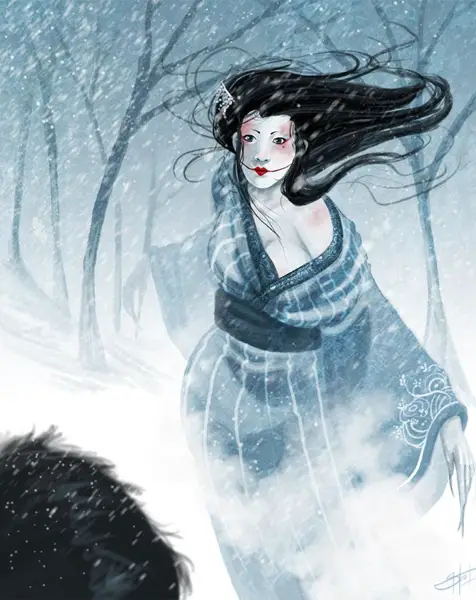
Yuki-onna (snow woman) is a strikingly beautiful woman with snowy white skin, long black hair and dressed in a pure white kimono. She is not a well-known yokai in most of Japan, but she is often mentioned in higher elevations where there is a good deal of snow fall. Yuki-onna glides over the snow like a ghost, but she is actually classified as a demon that is a danger to those that have the poor luck of encountering her.
Yuki-onna is similar to the succubus, feeding on the life force of her victims. She often appears during heavy snow storms and freezes her victims with her icy breath. She then sucks the life essence from them, leaving behind an empty husk.
Legends of Yuki-onna vary according to location. In some areas, she sometimes spares the life of her mortal victim, falling in love and even marrying them. In other locations, Yuki-onna only appears at specific times. Legends of the Iwate prefecture say she appears during Little New Years, which falls on January 15th and then leaves on the first day of February.
Continue Reading on Next Page:






